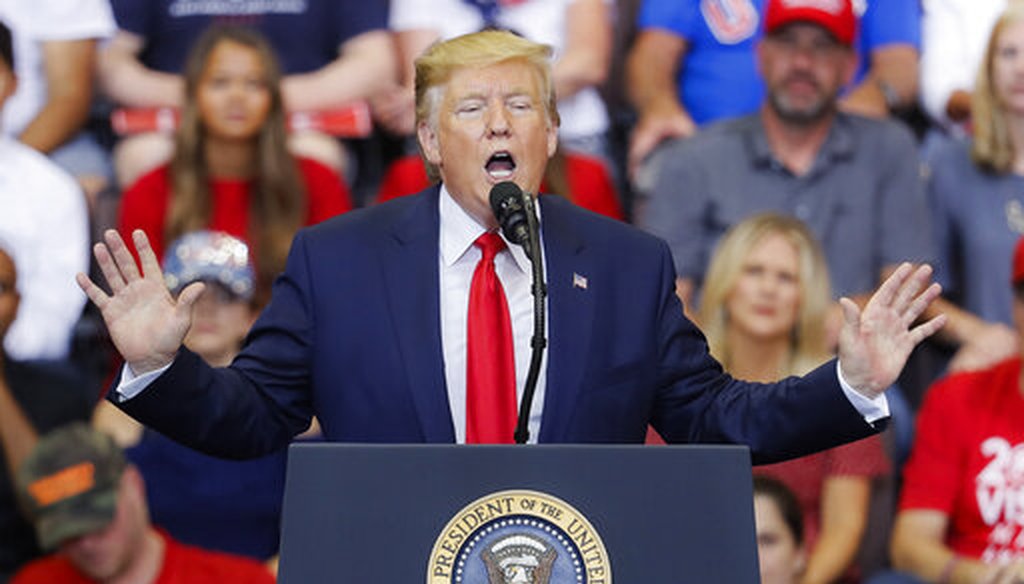

Our only agenda is to publish the truth so you can be an informed participant in democracy.
We need your help.


President Donald Trump speaks at a campaign rally Aug. 1, 2019, in Cincinnati. (AP Photo)
Days after President Donald Trump disparaged Baltimore as "a rat and rodent infested mess," he claimed the city’s homicide problem is worse than some of the world’s most dangerous countries.
During an unscripted moment at a rally in Cincinnati, the president asked the crowd to name another location with a reputation for violence.
"The homicide rate in Baltimore is significantly higher than El Salvador, Honduras, Guatemala. I believe it’s higher than — give me a place that you think is pretty bad," Trump said Aug. 1.
Trump listened to the crowd. Then he said, "The guy says ‘Afghanistan.’ I believe it’s higher than Afghanistan."
The line got a reaction from the crowd, and in a most literal sense, Trump has a point. But experts who study crime say comparing a city to a country is a misleading political talking point.
Baltimore, a city of just over 600,000, saw 309 homicides last year. That translates to a rate of more than 51 homicides for 100,000 residents.
That puts Baltimore’s homicide rate higher than El Salvador (50), Honduras (41), Guatemala (22) and Afghanistan (7), based on the most recent available annual data. (The data isn’t perfect, as we’ll note later.)
Note: The United Nations said deaths from armed conflict are typically excluded from data on intentional killings, but also notes there are "challenges of determining the nature of conflict versus non-conflict deaths in Afghanistan."
So that’s the approach Trump took to make his claim. But it’s a flawed one, experts told us. To better understand, consider the difference in crime rates of urban and rural areas.
Typically, cities experience more crime, including homicides, than rural areas.
Based on population density, the city of Baltimore is considered an urban area. By contrast, the Northern Triangle countries, as well as Afghanistan, are a mix of both urban and rural.
For that reason, measuring Baltimore’s homicide rate against those of entire countries is foolhardy.
"Baltimore is 100% urban, but a substantial percent of each nation's population live in rural areas," said Jay Corzine, a sociology professor at the University of Central Florida. "It is a comparison between apples and oranges."
The State Department, as part of its annual survey of crime and safety abroad, took note of the urban-rural crime gap in El Salvador. Last year, five municipalities that account for only 22% of El Salvador’s population saw 40% of the country’s homicides, according to the State Department’s Overseas Security Advisory Council.
A fairer measure would be to compare the homicide rates of Baltimore with a place like San Salvador, El Salvador’s capital and its most populous city. According to a ranking of the world’s most dangerous cities by the Mexican nongovernmental group Citizens' Council for Public Security, in 2017 San Salvador’s homicide rate was 59 per 100,000 residents — higher than Baltimore’s 2018 homicide rate.
Philip Cook, a sociologist at Duke University, noted that rates fluctuate depending on a number of factors, and rates in Central America can be especially volatile.
The homicide rate in El Salvador in 2015 was 103 — more than double its 2018 number. Cook added that some Central American data also tend to undercount the true number of homicides, another complicating factor when comparing it to an American city.
"Given the likelihood of a substantial undercount," Cook said, "I would not bet the ranch that El Salvador was safer than Baltimore in 2018."
Another way to look at homicide rates would be to compare Maryland, which includes Baltimore, to the countries Trump mentioned. In that case, however, the comparison falls apart.
Maryland (with a population a little over 6 million) had a homicide rate of 9 per 100,000 people, compared to El Salvador (50), Honduras (41), Guatemala (22) and Afghanistan (7).
Trump said Baltimore has a higher homicide rate than El Salvador, Honduras, Guatemala and Afghanistan.
The comparison is flawed, because it uses the homicide rates of entire countries — which are a blend of relatively higher-crime urban areas and lower-crime rural areas — as a measuring stick to gauge the level of violence in a city.
We rate this Half True.
President Donald Trump, tweet, July 27, 2019
President Donald Trump rally in Cincinnati, Aug. 1, 2019
White House, tweet, Aug. 1, 2019
NBC’s Baltimore affiliate WBAL, "Baltimore ends 2018 with 309 homicides," Jan. 2, 2019
U.S. Census data, "Baltimore city, Maryland," accessed Aug. 2, 2019
State Department, "El Salvador 2019 Crime & Safety Report," April 25, 2019
Report from the National Autonomous University of Honduras’s Observatory of Violence, Dec. 2018
State Department, "Guatemala 2019 Crime & Safety Report," Feb. 28, 2019
World Health Organization, "Homicide Estimates by country," accessed Aug. 2, 2019
National Bureau of Economic Research, "Why Is There More Crime in Cities?," Jan. 1996
Citizens' Council for Public Security, ranking of the world’s most dangerous cities, via Business Insider, March 6, 2018
InSight Crime, "El Salvador to Omit Key Data From Official Homicide Tally," July 18, 2019
Email interview Jay Corzine, a sociology professor at the University of Central Florida, Aug. 2, 2019
Email interview with Philip Cook, a sociologist at Duke University, Aug. 2, 2019
In a world of wild talk and fake news, help us stand up for the facts.
